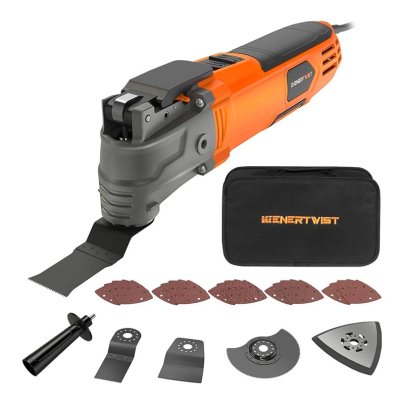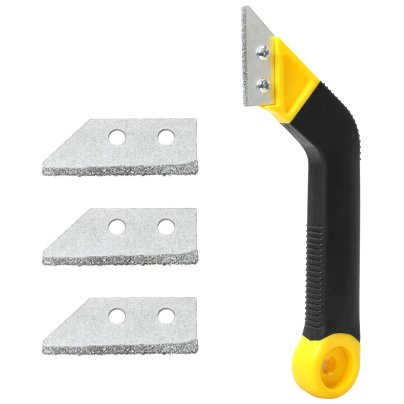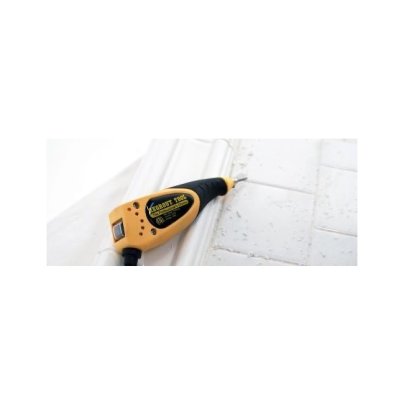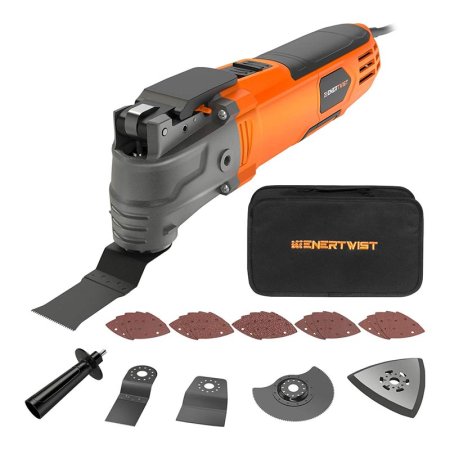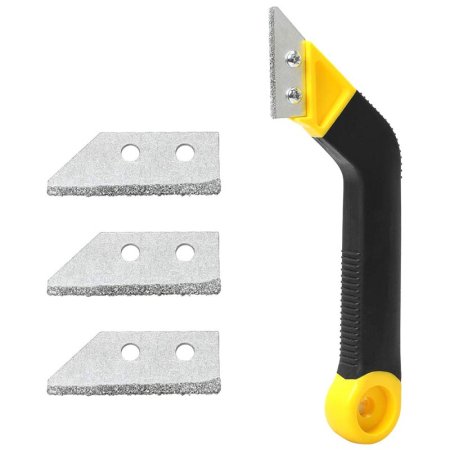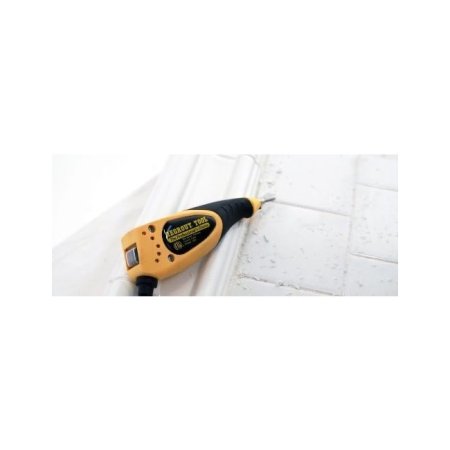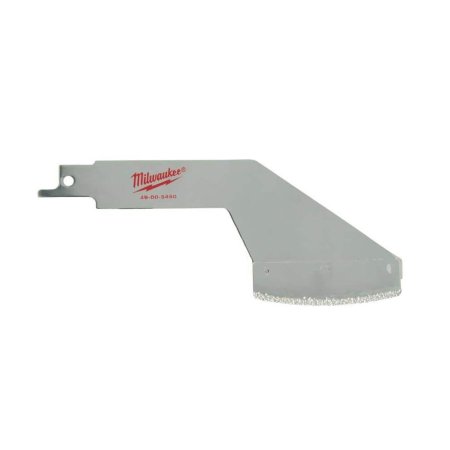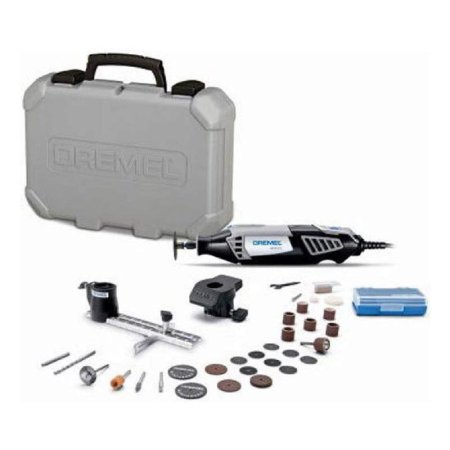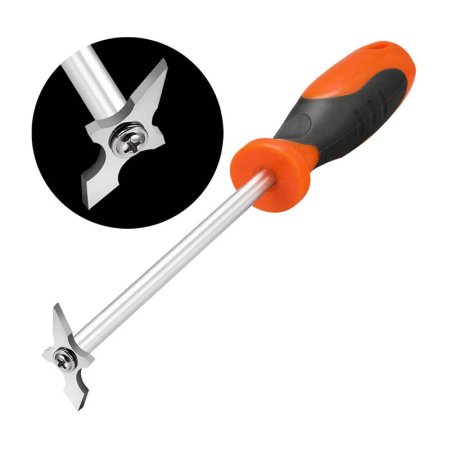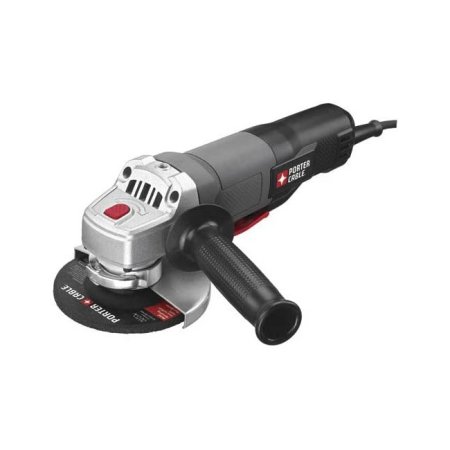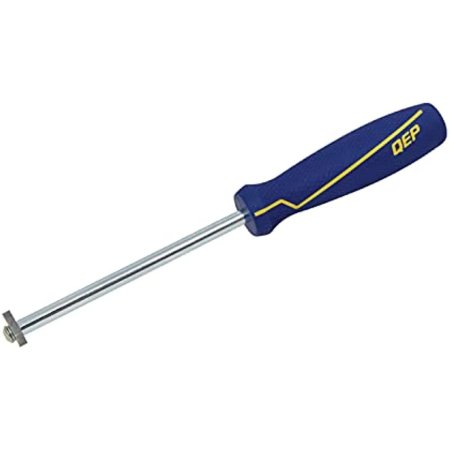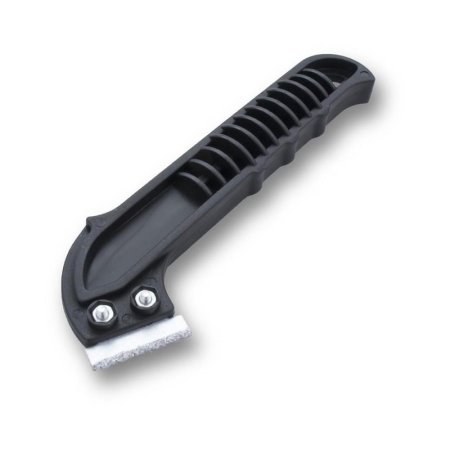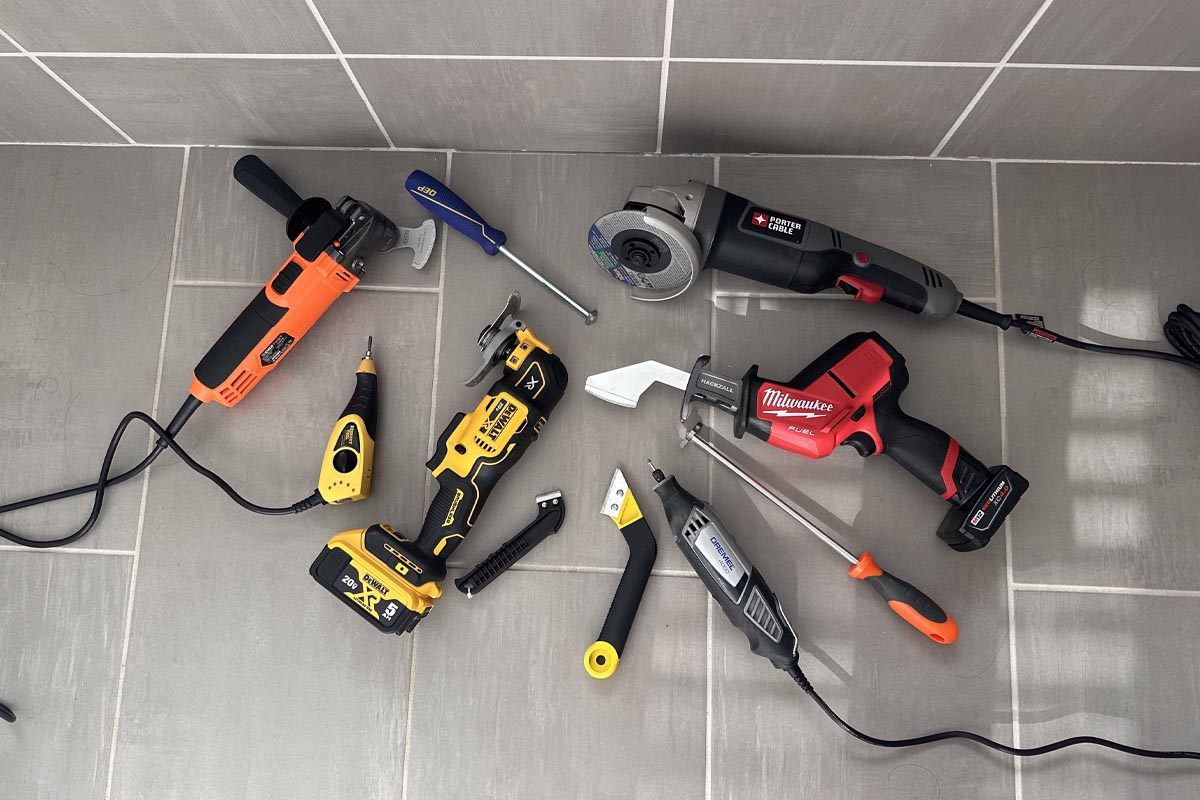
We may earn revenue from the products available on this page and participate in affiliate programs. Learn More ›
Old, dirty grout is one of the main offenders in making a bathroom or kitchen look shabby, but the good news is that you can easily replace it with a good set of grout removal tools. Cleaning grout or swapping it out entirely is a great way to refresh your space, and while grout removal is typically a labor-intensive process, the right tools can make things go more smoothly and speedily. In an effort to find the best grout removal tool for the job, we tested 10 different tools, ranging from small hand tools up to large electric oscillating tools and angle grinders.
Our favorite tool for the job was the Enertwist Oscillating Tool Kit. It produces ample power for grinding away grout with speed controls and a clear sightline to the blade that make it possible to work on narrower joints. And it does all this while also managing to be affordable. Ahead, find out what to look for when shopping for one of the best grout removal tools and check out all of our results for 10 tools we tested.
- BEST OVERALL: Enertwist Oscillating Tool Kit
↓ Jump to Review - BEST BANG FOR THE BUCK: Coitak Angled Tile Grout Saw
↓ Jump to Review - BEST ELECTRIC: Regrout Tool Electric Grout Remover
↓ Jump to Review - BEST CORDLESS: DeWalt 20V MAX XR 3-Speed Oscillating Multi-Tool Kit
↓ Jump to Review - BEST RECIPROCATING BLADE: Milwaukee Grout Removal Tool
↓ Jump to Review - BEST ROTARY: Dremel 4000-2/30 High-Performance Rotary Tool Kit
↓ Jump to Review - BEST MANUAL: Reetree Grout Removal Tool
↓ Jump to Review - BEST GRINDER: Porter-Cable 7½-Amp Small Angle Grinder
↓ Jump to Review - BEST FOR SMALL SPACES: QEP Grout Remover
↓ Jump to Review - BEST FOR SMALL JOBS: QLT by Marshalltown Mini Grout Saw
↓ Jump to Review
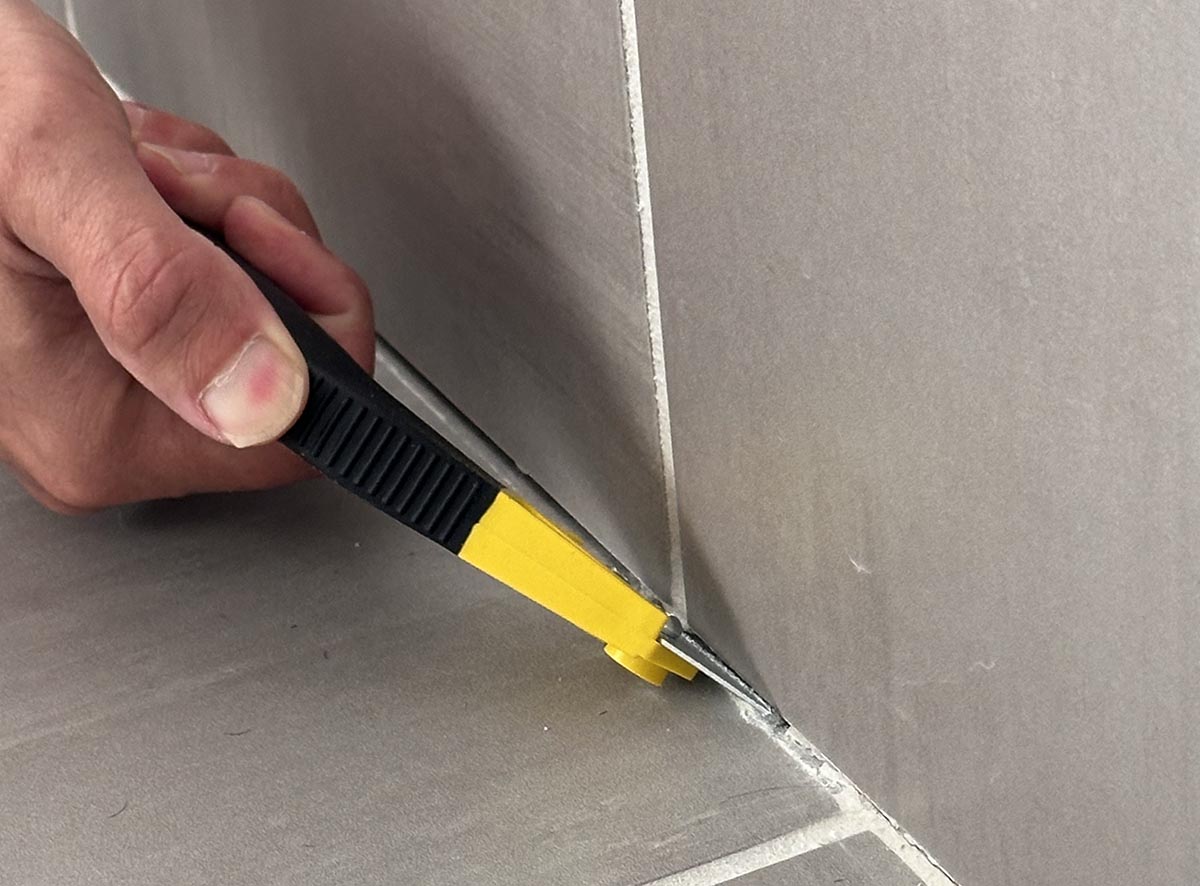
How We Tested the Best Grout Removal Tools
After narrowing the field to 10 tools, we tested each to see which models were the best of the bunch. We set to work using each tool to remove about a 0.125 inch depth of grout from a foot-long section of tiled surface. We tested each on sanded grout from tiles on an outdoor patio and unsanded grout on indoor bathroom tiling. While testing, we considered how quickly and effectively each tool removed grout as well as how easy each tool was to control. We also evaluated how well they worked with different grout types and widths and their ability to work in tighter spots, such as in corners and around cabinets and fixtures. We considered ease of use factors, including how simple it was to load blades and how comfortable the tools were to grip.
| Testing Stats | |
| Products tested | 10 |
| Time spent testing | 5 hours |
| Tests performed | 2 |
| Price range | $6 to $150 |
How We Chose the Best Grout Removal Tools
To find the top grout removal tools available from reputable manufacturers and sellers, we researched each potential option thoroughly, determining which tools were the best for removing tile grout. There are a variety of tools that can be used to remove grout from tiles, which made it easy to find potential products; however, the wide selection also made it difficult to narrow our list down. To help choose the top tool, we considered each product’s weight, whether it came with a blade, the type of blade, the type of tool, and the suitability of the tool for grout removal tasks.
Preference was given to lightweight products with one or more grout removal blades. Stainless steel blades were acceptable, but products with carbide or tungsten steel blades stood out from competitors. In addition, a product was dropped from consideration if there was any indication that the tool could not adequately remove grout.
We reached out to professional contractors for their insight. “Manual grout removal tools are great for small-scale projects or situations where precision is paramount,” says Kristin Hintlian, co-owner of Bonsai Builders, remodeling specialists in Spencer, Massachusetts. “On the other hand, electric grout removers offer speed and efficiency, making them ideal for bigger projects.” She says oscillating multipurpose tools are often used in her business. “They are compatible with both sanded and unsanded grout and adjustable to tackle different grout line widths. The variable-speed setting helps us tailor the tool’s aggression, minimizing tile damage.”
Our Top Picks
Our favorite grouting tools encompass a variety of types and styles, from angled grout saws to small angle grinders. Read on to find an option that will help you get the job done.
Best Overall
Enertwist Oscillating Tool Kit
Product Specs
- Type: Oscillating
- Accessories: 33-piece kit with blades, sandpaper, and more
- Weight: 3.6 pounds
Our Ratings: Ease of Use 4.7/5; Maneuverability 3/5; Performance 5/5; Durability 5/5; Value 5/5
What We Like
- Versatile and affordable; makes light work of removing tough grout
- Easy-to-use tool-free blade-change system; choice of 6 speeds
- Comprehensive kit means the same tool can be used for different DIY tasks
What We Don’t Like
- Bulky size doesn’t fit into corners easily
With a 4.2-amp motor, this oscillating tool is well equipped to tear through grout. We tested it using a carbide-edged blade to grind through 0.375-inch-wide grout on an outdoor patio. With its 16,000 oscillations per minute, it moved through grout with ease. We also liked the six speed controls, which allowed us to slow down to take on narrower grout lines. While the Enertwist oscillating tool was one of the more powerful tools we tested, it muffled vibration well and offered a great sight line to the blade, which made it surprisingly easy to keep inside the grout lines. It was also one of the louder tools we tested, such that we recommend using ear protection when operating it.
Along with its excellent grout-removing power, we also liked its toolless blade change design, a nice feature when taking on larger jobs that may require numerous blade changes. As a corded oscillating tool, the Enertwist does require wrestling with an extension cord. But while a cordless oscillating tool may offer convenience, you’ll also pay twice as much for one. The Enertwist provides the same level of performance at a reasonable price.
Get the Enertwist grout removal tool at Amazon.
Best Bang for the Buck
Coitak Angled Tile Grout Saw
Product Specs
- Type: Manual
- Accessories: 3 blades
- Weight: 4.16 ounces (including spare blades)
Our Ratings: Ease of Use 3.5/5; Maneuverability 5/5; Performance 4.5/5; Durability 4.5/5; Value 5/5
What We Like
- Lightweight, low-cost tool with aggressive diamond-style blade that minimizes effort
- Durable plastic handle is comfortable to hold; has convenient hanging hole
- Blade thickness of just 0.07 inch is fine enough for narrow joints
What We Don’t Like
- Best when used for small areas as it can be tiring to operate for several hours
We looked at several budget-friendly grout removal tools and found that quality can vary considerably. The Coitak grout saw was one of the better models and manages to combine low cost with ease of use.
We found the plastic handle to be surprisingly durable, lightweight, and easy to grip. And while the tool handle is short, it’s positioned at such an angle that we were still able to apply enough leverage to dig into the tile grout. The coarse carbide blade did an excellent job of grinding through grout during out testing. It was also thin enough that we were able to take on thinner grout lines while mostly avoiding the surrounding tile. We liked the fact that you could double up blades to grind through thicker grout lines. The blade was also ideal for simply stripping away any mold or mildew buildup as an alternative to grout cleaner.
While we liked how effective this grout remover was, it is still a manual one, so plan on putting in a fair amount of elbow grease if your goal is to remove enough grout to regrout. This effective little tool costs less than $10 and comes with four blades. You won’t find a cheaper way to remove grouting.
Get the Coitak grout removal tool at Amazon.
Best Electric
Regrout Tool Electric Grout Remover
Product Specs
- Type: Chipping
- Accessories: 2 tungsten carbide tips
- Weight: 1.04 pounds
Our Ratings: Ease of Use 3.5/5; Maneuverability 4/5; Performance 2/5; Durability 4.5/5; Value 3/5
What We Like
- Dedicated professional-grade tool designed solely for rapid grout removal
- 3 speeds and 2 tungsten carbide tips provide options for all kinds of grout lines
- Lightweight and easy to handle with a chipping action that minimizes dust
What We Don’t Like
- Some users thought it needed to be more aggressive when tackling very hard grout
The electric Regrout Tool grout remover is one of a few models designed specifically for grout removal rather than as a general-purpose oscillating or rotary tool. It uses a pulsing action to chip away at the grout, breaking it up rather than grinding it down and creating clouds of unpleasant dust.
While we liked the idea of a jackhammer approach to removing grout as opposed to the grinding action that produces dust, the Regrout Tool’s effectiveness was only so-so. It worked great for some crumbling grout that was around the tile in our bathroom, chipping it away with ease. We also liked the fact that the two tips worked well with thinner grout. However, for harder, more established grout, it struggled to put much of a dent in it, even when set to its highest speed.
Since the ReGrout Tool is designed to pound away grout, it also sends a lot of vibration to your hand. Even a fairly short grout removal session left our hand feeling numb from the vibrating action. In short, we were expecting more for the price. While the Regrout Tool is a good option for removing grout that’s already beginning to degrade, we wouldn’t recommend it for any other purpose.
Get the Regrout Tool grout remover tool at Amazon.
Best Cordless
DeWalt 20V MAX XR 3-Speed Oscillating Multi-Tool Kit
Product Specs
- Type: Oscillating
- Accessories: 2 wood cutting blades (grout cutting blade not included)
- Weight: 2.6 pounds
Our Ratings: Ease of Use 4/5; Maneuverability 4/5; Performance 5/5; Durability 5/5; Value 4.3/5
What We Like
- Comes with 2 high-output 5-amp-hour batteries, charger, and carry bag
- Tool-free quick-change accessory system takes most third-party blades
- Features variable trigger with 3 speed ranges plus useful built-in flashlight
What We Don’t Like
- Comes with a premium price tag, and grout removal blades are extra
Instead of worrying about tripping over a power cord, invest in this cordless oscillating tool by DeWalt to remove grout quickly and efficiently. The tool weighs only 2.6 pounds and comes with two batteries and a charger, so one battery can always be charged while the other is in use. The oscillating carbide grout removal blade is sold separately as the tool only comes with wood cutting blades.
Equipped with the grout removal blade, the DeWalt makes grout removal easy. We tested it on 0.25-inch-wide grout on a tiled patio, and it did a great job of grinding it out. The tool is also compact enough that we could easily operate it while seeing exactly where the blade was, helping us to avoid hitting the tile surface. Its ergonomic handle and ample rubberized grip make it comfortable to use over longer projects. That said, it does take some skill to avoid slips. This is also a tool for 0.375-inch grout or wider. The blade is simply too thick to handle thinner 0.25-inch grout lines without damaging the tile.
DeWalt’s oscillating tool is certainly one of the more expensive solutions for removing grout from tile, but it’s worthwhile if you have other jobs around the house that you can use this versatile tool to tackle.
Get the DeWalt grout removal tool at Amazon, Lowe’s, or The Home Depot.
Best Reciprocating Blade
Milwaukee Grout Removal Tool
Product Specs
- Type: Blade
- Accessories: N/A
- Weight: N/A
Our Ratings: Ease of Use 3.5/5; Maneuverability 3/5; Performance 4/5; Durability 4/5; Value 4/5
What We Like
- Works with most reciprocating saws
- Grinds grout out very quickly
- Affordable option if you already own a reciprocating saw
What We Don’t Like
- Difficult to control
This specially designed 5-inch carbide grit blade is meant to remove grout using a reciprocating saw. We put this blade to the test using Milwaukees’ compact Hackzall reciprocating saw. We had mixed results.
Backed by the power of a reciprocating saw, the blade cuts quickly through grout. That said, we found it difficult to use. The blade has a tendency to bounce and travel, which made it difficult to keep inside narrow joints. We found that using the Hackzall’s variable-speed trigger to slow the blade down made it easier to control and less likely to travel. Still, it requires some skill to keep it from hitting the surrounding tile. That said, while Milwaukee says you can use it for grout lines as small as 0.125 inch thick, we’d only recommend using it for grout lines that are 0.375 inch thick or wider to avoid damaging the tile.
We should also note that the Hackzall is compact and far lighter than a full-size reciprocating saw. Using a full-size saw would make it even more difficult to control the blade. Given that, we’d recommend using it with more compact reciprocating saws that offer straight line cutting as opposed to orbital cutting motions.
Get the Milwaukee grout removal tool at The Home Depot.
Best Rotary
Dremel 4000-2/30 High-Performance Rotary Tool Kit
Product Specs
- Type: Rotary
- Accessories: Cutting, grinding, and sanding blades
- Weight: 22.5 ounces
Our Ratings: Ease of Use 4/5; Maneuverability 4/5; Performance 5/5; Durability 4/5; Value 4/5
What We Like
- Renowned high-quality multi-tool with 30 accessories, including blades for narrow joints
- Wide range of speeds allows for precise adjustment to suit task
- Light and easy to maneuver with comfortable grip and fast tool changing
What We Don’t Like
- Cordless models offer greater freedom of movement, and some accessories wear out rapidly
With a name that’s synonymous with rotary tools, Dremel clinching a spot on our “best” list is no surprise. The Dremel 4000 features a variable-speed dial that ranges from 5,000 to 35,000 revolutions per minute (RPM), which is enough power for unsanded or sanded grout removal.
Unsurprisingly, the Dremel excelled at grout removal, carving into grout easily when using a special bit for the job. And unlike other tools we tested, Dremel has a stable feel, which was key to keeping it in-line as we worked to grind away grout. That’s not to say it isn’t without its flaws. The rotary speed of the tool can cause it to jump out of the grout line and run across the tile surface if you crank the speed up too high or don’t hold it firmly against the grout as you work. It also produces a lot of fine dust, so be prepared to clean the area around you and yourself when the job is done.
The Dremel is one of the pricier options when it comes to grout removal, but keep in mind that it can also perform countless other jobs around the house. If you’re someone who finds themselves doing a variety of DIY work, it’s worth the investment. Otherwise, go with a more affordable option.
Get the Dremel grout removal tool at Amazon, The Home Depot, or Walmart.
Best Manual
Reetree Grout Removal Tool
Product Specs
- Type: Manual
- Accessories: 4 blades
- Weight: 0.24 pounds
Our Ratings: Ease of Use 3/5; Maneuverability 5/5; Performance 4.5/5; Durability 4.5/5; Value 4.5/5
What We Like
- Extremely lightweight with ergonomic soft-grip handle
- Durable tungsten steel blades can slice through all kinds of grout
- 3 tip profiles designed for fine, moderate, and deep tile penetration
What We Don’t Like
- Spare blades seem impossible to find, so the whole tool would need to be replaced
You won’t be removing a lot of grout with the Reetree grout remover, but for small grout removal jobs and detailed work power tools can’t manage, it’s a superior choice. This grout scraping tool is all about precision. There are three tip shapes designed for fine, moderate, and deep penetration between tiles. We were able to remove grout from narrow 0.125-inch lines on bathroom grout without accidentally scarring the tile. The Reetree can handle both unsanded and sanded grout.
The tool was easy to control thanks to its ergonomic grip, and we were able to guide it into corners with little trouble. Its length also helped us to bear down on the grout, making it easier to grind it away with the blade. That said, this tool is no miracle worker. It took some effort to remove a 3-foot stretch of grout. Your arm will certainly get a workout. We attempted to use it to remove 0.375-inch thick grout on our backyard tile; it wasn’t up for the job as the blade is too narrow to remove this thicker grout effectively. This is clearly a tool for thin tile lines.
If removing old grout around delicate bathroom tile is the job, then the Reetree is a great option. For bigger grout removal projects, however, it’s worth looking for something with a motor.
Get the Reetree grout removal tool at Amazon.
Best Grinder
Porter-Cable 7½-Amp Small Angle Grinder
Product Specs
- Type: Rotary
- Accessories: None
- Weight: 3.5 pounds
Our Ratings: Ease of Use 4/5; Maneuverability 3/5; Performance 5/5; Durability 5/5; Value 4/5
What We Like
- Powerful tool; tackles heavy-duty grout removal indoors and out
- Cast metal gear housing and sturdy build
- Side handle can be set in 3 positions for maximum control at different angles
What We Don’t Like
- Precise control can be difficult; not practical for hard-to-reach areas
For big, tough grout removal jobs, this angle grinder from Porter-Cable is a great choice. The powerful 7.5-amp motor is perfect for sanded and epoxy grout, though it’s a little too much tool for unsanded grout.
We loaded this angle grinder with a 0.0625-inch thick Masonry cut-off wheel, sold separately. When applied to the 0.375-inch thick grout lines of patio tile, the 10,000 RPM of force was apparent. The Porter-Cable angle grinder blasted through the grout, allowing us to remove several feet in minutes. While we loved the grout removing ability, controlling all that power was a challenge. As we learned, it will grind through tile if you’re not careful. That said, we were able to strip grout without collateral damage after just a little practice.
At 3.5 pounds, this angle grinder is certainly heavier than the other motorized grout removal solutions we tried; however, we found it to be comfortable to use. And since it removes grout quickly, it requires far less elbow grease than manual options. A wheel guard helps protect your face and hands while you grind away, but expect a lot of dust (as you’d find with any angle grinder). While it has a steeper price tag than manual options, it’s a good investment if you have other jobs around the house that require the services of an angle grinder.
Get the Porter-Cable grout removal tool at Amazon or Tractor Supply Co.
Best for Small Spaces
QEP Grout Remover
Product Specs
- Type: Manual
- Accessories: 1 blade
- Weight: 0.3 pounds
Our Ratings: Ease of Use 5/5; Maneuverability 4/5; Performance 4/5; Durability 4.5/5; Value 4.5/5
What We Like
- Lightweight, economical tool ideal for use in hard-to-reach areas
- Incorporates 3 different tip sizes for wide, medium, and narrow joints
- Strong carbide-tipped blade offers sharpened scraping edges for increased efficiency
What We Don’t Like
- Requires a fair amount of manual effort
The QEP grout removal tool has a modest 9-inch length, and the head has a triangle-shaped blade with three points for fine to moderate penetration into the grout. It also has six sharpened scraping edges to help improve overall efficiency.
We tried this manual tool on a narrow 0.125-inch-wide grout and it worked very well, removing a significant layer of grout with each stroke, thanks to its carbide tip. The small size of the blades made it easy to use without damaging the tile. And the handle provided enough length for us to bear down on the tool without being so long that it was difficult to use in tighter spaces. This grout tool is very lightweight, and the ergonomic grip is comfortable enough to hold for longer sessions, though it is important to note that it does require a fair amount of effort to remove grout, just as any manual tool does.
To be clear, this is a tool clearly designed for narrower grout lines. The small blade only removes a thin line of grout with each stroke, which meant it was far too narrow to use on the 0.25-inch-thick grout lines of our patio.
Get the QEP grout removal tool at The Home Depot.
Best for Small Jobs
QLT by Marshalltown Mini Grout Saw
Product Specs
- Type: Manual
- Accessories: 1 blade
- Weight: Less than an ounce
Our Ratings: Ease of Use 4/5; Maneuverability 5/5; Performance 4/5; Durability 4/5; Value 4.5/5
What We Like
- Small size makes it easy to fit into tight spaces
- Affordable price
- Thin blade works with narrow grout lines
What We Don’t Like
- Too small to handle larger jobs
Marshalltown’s mini grout saw may be too small for extensive grout removal, but it’s a great option for smaller scale projects, such as repairing small sections of grout or replacing a cracked tile. Its blade measures 0.0625 inch wide, making it suitable for thin grout lines. It’s also just over an inch long, which is too small for bigger grout removal projects but nimble enough for small spaces.
We had no problem working in and around tight corners with this mini grout saw. And though small, the angle of the handle and ergonomic grip allowed us to get good leverage while using it. The carbide blade also does a nice job of grinding through grout. Best of all, this grout removing tool is cheap, making it one of the most affordable ways to remove grout. It’s a great budget-priced option if you don’t have much grout to remove.
Get the QLT by Marshalltown grout removal tool at Lowe’s.
Jump to Our Top Picks
What to Consider When Choosing a Grout Removal Tool
When looking for the best tile grout remover, consider some important aspects and tips on working with grout to ensure that you pick the best tool for you and your project.
Types of Grout Removal Tools
There are many methods for removing and changing grout, but each tool has benefits and drawbacks. In general, the more powerful the tool, the more dust it will generate, so be sure to wear a face mask—and all other applicable personal protective equipment—while removing grout.
- An oscillating tool equipped with a grout removal blade is one of the best options, and with the right blade, can be used on any type of grout. Rather than grinding grout into messy dust like a reciprocating saw, rotary tool, or angle grinder, this tool operates at a slower speed to take out larger pieces of grout using an oscillating motion. Though far faster and easier than manual grout removal, an oscillating tool takes more time and effort than a higher-powered option.
- A reciprocating saw with a grout grabber blade is ideal for removing hard grout, like sanded or epoxy varieties. It can do the job quickly, but if you lack experience with these powerful saws—which can jump around during use and damage nearby tiles—go slowly until you get the hang of it.
- A rotary tool with a grout removal accessory is the slowest of powered grout removal options, yet it will still kick up a lot of dust, so it’s best for smaller grout removal projects. To avoid hitting the edge of a tile with a rotary tool, ensure the gap between the tiles is at least 0.125 inch.
- An angle grinder is a powerful tool best suited to large grout removal projects with many long, straight lines. They can easily cut through epoxy, sanded, or unsanded grout. Like rotary tools, their spinning disk requires a 0.125-inch gap between tiles to avoid damage. The main drawback with angle grinders is the excessive dust they fling into the air, quickly creating a breathing hazard, so wear a standard N95 dust mask to filter out particles.
- A manual grout removal tool generally consists of a handle and blade with varying degrees of shape and ergonomic support. It makes grout removal long, hard, and tedious work, so only rely on it for very small projects with unsanded grout or for cleaning up tile lines after using a powered option.
Manual vs. Mechanical
The size and time frame of the project will determine whether you use manual or mechanical grout removal tools. Note that the mechanical tools mentioned here have various uses beyond grout repair, such as cutting and sanding.
- Manual grout removal tools can be employed for small projects, like a powder room floor or a kitchen backsplash. They also come in handy for precise detail work, such as removing fine deposits left on tiles after a power tool removes the bulk of the grout. A grout knife or grout scraper for sanded grout and a carbide cutter for unsanded grout are among your options. Don’t try to remove epoxy grout with a manual tool.
- Mechanical grout removal tools are faster and better suited to large projects. Less powerful options, like an oscillating or a rotary tool, easily cut through unsanded grout. In contrast, more powerful options like a reciprocating saw or angle grinder will handle sanded and even epoxy grout.
Blade Material
Blade material becomes important when working with tough grout types, like sanded and epoxy grout.
- Carbide blades are the go-to for most grout removal tools as they are both moderately priced and hard enough to handle the toughest grout.
- Tungsten steel blades are harder and pricier than carbide options, but they work fast and are especially good for dealing with a lot of epoxy grout.
- Stainless steel blades, the softest, cheapest option, aren’t effective for hard grout. Use them for unsanded grout removal or to clean up tile edges.
Type of Grout
There are three main types of grout you’re likely to encounter, and they range in difficulty to remove.
- Unsanded grout is most likely seen on tiled surfaces such as walls and showers in newer homes. It’s easy to penetrate with a manual removal tool, even with a stainless steel blade. If going mechanical, stick to lower-power options like an oscillating or rotary tool to reduce the risk of damaging tiles.
- Sanded grout is usually found on tiled floors and walls or outside settings of older homes. Very dense and solid with a primary component of silica sand and cement, it’s difficult to remove manually and should be tackled with a mechanical solution and a carbide blade.
- Epoxy grout, the hardest, coarsest type, is typically used in the showers of swimming pools and gyms, though it’s starting to gain popularity with residential tiling contractors. If a manual grouting tool barely scratches the grout in question, it may be epoxy-based. A powerful tool such as an angle grinder or reciprocating saw should be used to remove epoxy grout.
Additional Features
The extra features of grout removal tools range widely. Mechanical tools may have speed options, trigger locks, built-in LED lights for better visibility, and convenient carrying cases. Manual options include ergonomic grips, replacement blades, and variable-blade tips for fine, moderate, or deep penetration.
FAQs
To make sure that you have all the information you need to choose the best grout removal tool, take a look at these commonly asked questions about the removal of grout and the detailed answers below. If your grout only needs a thorough cleaning, you might also consider investing in a good grout cleaner.
Ease of use often depends on how familiar the user is with the specific tool, so it’s difficult to state which method would be the easiest for everyone. Still, one of the easiest options for removing grouting is to use an oscillating electric grout removal tool. The oscillation movement pulls out large pieces of grout instead of grinding through several layers with a Dremel grout removal tool or dealing with the power of a reciprocating saw.
Learning how to remove grout by hand isn’t difficult, but the process is time-consuming and takes a lot of physical effort. Many manual grout removal tool options are available, so find the tool that best meets your needs and then use it to scrape, break, and remove pieces of grout from between the tiles. When you put new grout down, don’t forget to protect it with a good grout sealer.
If you are removing grout with electric grout removal tools, manual tools, or using a specific grout removal attachment with a multifunctional power tool, it’s important to know that you only need to remove about 0.125 inch of grout to embed new grout between the tiles. However, if the existing grout is broken, chipped, cracked, shrunk, or otherwise damaged, it should be removed.
If the existing grout is in decent condition, then you only need to remove about 0.125 inch of grout to regrout the tiles. However, any damaged grout should be completely removed and replaced.
Meet the Tester
Tony Carrick is a freelance writer specializing in home improvement, landscaping, technology, home security, and design. His articles have been featured on such sites as Angi, Popular Science, Futurism, 360 Reviews by U.S. News & World Report, Domino, and more. Carrick has conducted rigorous product testing on everything from power tools to home security systems to backyard grills. With each review, his goal is to help readers determine whether a product meets their needs and if it is or isn’t worth its price tag.
Additional research provided by Timothy Dale.
